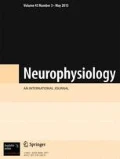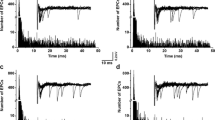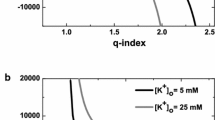Abstract
Analysis of discrete distributions of basic EPSP amplitudes at sensorimotor, proprio- and reticulo-motoneuronal synapses in the frog by means of the convolution of two binomial distributions revealed that the number of transmitter release sites operating was greater than that calculated by means of binomial distribution. Probability levels of transmitter release sites responding in unison to nerve impulses are dissimilar (at not more than 0.1–0.3) and remained constant. Interference with the release mechanism induced blockade of release sites. Impairment of the process triggering transmitter release produced a sharp decline in the probability of release sites operating in unison.
Similar content being viewed by others
Literature Cited
B. I. Balanter, Probability Methods in Physiology [in Russian], Nauka, Moscow (1977).
A. G. Bart and V. M. Kozhanov, Modeling Synaptic Transmission by a System of Extended Binomial Distributions [in Russian], Biomedical Cybernetics-85, Nauka, Leningrad (1986), pp. 12–14.
A. G. Bart, A. E. Dityatev, and V. M. Kozhanov, “Quantal analysis of postsynaptic potentials at interneuronal synapses: recovery of a signal from noise,” Neirofiziologiya,20, No. 4, 479–487 (1988).
A. L. Babalian and N. M. Chmyckova, “Morphophysiological description of connections between single ventrolateral tract fibers and individual motoneurones in frog spinal cord,” Brain Res.,407, No. 2, 394–397 (1987).
E. F. Barrett and C. F. Stevens, “Quantal independence and uniformity of presynaptic release kinetics at the frog neuromuscular junction,” J. Physiol.,227, No. 3, 665–689 (1972).
M. R. Bennett and N. A. Lavidis, “The effect of calcium ions on the secretion of quanta evoked by an impulse at nerve terminal release sites,” J. Gen. Physiol.,74, No. 4, 429–456 (1979).
G. D. Bittner and J. Harrison, “A reconsideration of the Poisson hypothesis for transmitter release at the crayfish neuromuscular junction,” J. Physiol.,206, No. 1, 1–23 (1970).
T. J. Brown, D. H. Perkel and M. W. Feldman, “Evoked transmission release: statistical effect of nonuniformity and nonstationarity,” Proc. Natl. Acad. Sci., USA,73, No. 8, 2913–2917 (1976).
R. E. Burke and P. Rudomin, “Spinal neurons and synapse,” In: Handbook of Physiology, Vol. 1, Pt. 2 (1977), pp. 877–944.
J. B. Del Castillo and B. Katz, “Quantal components of the end-plate potential,” J. Physiol.,124, No. 3, 560–573 (1954).
J. B. Del Castillo and B. Katz, “Biophysical aspects of neuromuscular transmission,” Progr. Biophys. Biochem. Chem.,6, No. 1, 121–170 (1956).
A. C. Dolphin and R. H. Scott, “Inhibition of calcium current in cultured rat dorsal root ganglion neuron by (−)-baclofen,” Br. J. Pharmacol.,88, No. 1, 213–220 (1986).
J. Dudel, “Transmitter release from nerve terminals evoked by depolarization pulses contains a short phase of repression,” Pflügers Arch.407, No. 2, 134–141 (1986).
J. C. Eccles, “Do mental events cause neural events analogously to the probability of quantum mechanics?”, Proc. R. Soc., London, Ser. B.,227, No. 1249, 411–428 (1986).
R. Grantyn, A. I. Shapovalov, and B. I. Shiriaev,” Tracing of frog sensory-motor synapses by intracellular injection of horseradish peroxidase,” J. Physiol.,349, 441–458 (1984).
R. Grantyn, A. I. Shapovalov, and B. I. Shiriaev, “Relation between structural and release parameters at the frog sensory-motor synapse,” J. Physiol.,349, 459–474 (1984).
J. J. B. Jack, S. J. Redman, and K. Wong, “Modifications to synaptic transmission at group la synapses on cat spinal motoneurones by 4-aminopyridine,” J. Physiol.,321, 111–126 (1981).
H. Korn, A. Mallet, A. Triller, and D. S. Faber, “Transmission at a central inhibitory synapse. 2. Quantal description of release with a physical correlate for binomial n,” J. Neurophysiol.,48, No. 3, 679–707 (1982).
D. H. Perkel and M. W. Feldman, “Neurotransmitter release statistics: moment estimates for inhomogeneous Bernoulli trials,” J. Math. Biol.,7, No. 1, 31–40 (1979).
H. Parnas, J. Dudel, and I. Parnas, “Neurotransmitter release and its facilitation in crayfish. 7. Another voltage dependent process beside Ca entry controls the time course of phasic release,” Pflugers Arch.,406, No. 1, 121–130 (1986).
A. I. Shapovalov and B. I. Shiriaev, “Dual mode of junctional transmission at synapses between single primary afferent fibres and motoneurones in the amphibian,” J. Physiol.,306, 1–15 (1980).
A. I. Shapovalov and B. I. Shiriaev, “Selective modulation of chemical transmission at a dual-action synapse (with special reference to baclofen),” J. Gen. Physiol. Biophys.,1, No. 3, 423–433 (1982).
L. Stjärne and P. Astrand, “Discrete events measure single quanta of adenosine 5-triphosphate secreted from sympathetic nerve of guinea pig and mouse vas deferens,” Neuroscience,13, No. 1, 21–28 (1984).
D. J. Tracey and B. Walmsley, “Synaptic input from identified muscle afferents to neurons of the dorsal spinocerebellar tract in the cat,” J. Physiol.,350, 599–614 (1984).
A. Triller and H. Korn, “Transmission at a central inhibitory synapse. III. Ultrastructure of physiologically identified and stained terminals,” J. Neurophysiol.,48, No. 3, 708–736 (1982).
R. S. Zucker, “Changes in the statistics of transmitter release during facilitation,” J. Physiol.,229, No. 4, 787–810 (1973).
Additional information
A. A. Zhdanov State University, Leningrad; I. M. Sechenov Institute of Evolutionary Physiology and Biochemistry, Academy of Sciences of the USSR, Leningrad. Translated from neirofiziologiya, Vol. 20, No. 4, pp. 487–494, July–August, 1988.
Rights and permissions
About this article
Cite this article
Bart, A.G., Dityatev, A.É. & Kozhanov, V.M. Analysis of transmission at interneuronal synapses using a convolution of binomial distributions. Neurophysiology 20, 357–363 (1988). https://doi.org/10.1007/BF02198444
Received:
Issue Date:
DOI: https://doi.org/10.1007/BF02198444




